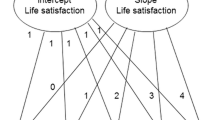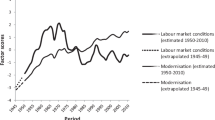Abstract
The study uses the deterioration of security situation in Israel (the “Intifada”) to investigate the uniqueness of results obtained previously in regard to Israel’s security-guard industry, as against other economic sectors, in regard to the employment stability and its implications for future career path. The findings emphasize the negative effect of a person’s mere presence in the labor market during the Intifada on his career path, irrespective of the industry in which he worked. They emphasize the variance attributed to the economic sector in which people hold their first job on their future employment career, as well as the variance attributed to working as a security guard during the Intifada, with the upturn in terror associated with it. The findings stress the role that policymakers should play for minimizing possible adverse effects on the earning trajectory and labor-market attachment of employed persons at a time of declining security and the emphasis and attention that should be given to persons employed in the security-guard industry at any time—due to the inferiority of permanent employment patterns in this industry in contrast to other industries—to minimize possible impairment to their earning trajectory and assure their long-term attachment to the labor market.

Source: Central Bureau of Statistics Labor Force Survey and processing by author

Source: Central Bureau of Statistics Labor Force Survey and processing by author

Source: Central Bureau of Statistics Labor Force Survey and processing by author

Source: Central Bureau of Statistics Income Survey and processing by author

Source: Income tax data and processing by author


Source: Income tax data and processing by author
Similar content being viewed by others
References
Abu-Taleb A, Rao MB, Zhang H (2003) Periodic inspection plans: the case of Weibull distribution. Metrika 58(1):15–30
Angrist JD (1990) Lifetime earnings and the Vietnam era draft lottery: evidence from social security administrative records. Am Econ Rev 80(3):313–336
Angrist JD, Lavy V (1997) The effect of a change in language of instruction on the returns to schooling in Morocco. J Labor Econ 15(1):S48–S76
Angrist JD, Lavy V (2001) Does teacher training affect pupil learning? evidence from matched comparisons in Jerusalem public schools. J Labor Econ 19(2):343–369
Asongu SA, Le Roux S (2017) Enhancing ICT for inclusive human development in sub-Saharan Africa. Technol Forecast Soc Change 118:44–54
Asongu SA, Nwachukwu JC (2016) The mobile phone in the diffusion of knowledge for institutional quality in sub-Saharan Africa. World Dev 86:133–147
Attanasio OP, Brugiavini A (2003) Social security and households’ saving. Q J Econ 118(3):1075–1119
Barmby T, Eberth B (2008) Worker turnover and job matching: implications for estimating the returns to tenure. Econ Lett 101(2):137–139
Berrebi C, Klor EF (2010) The impact of terrorism on the defence industry. Economica 77(307):518–543
Booth AL, Francesconi M, Garcia-Serrano C (1999) Job tenure and job mobility in Britain. Ind Labor Relat Rev 53(1):43–70
Borjas GJ (1981) Job mobility and earnings over the life cycle. Ind Labor Relat Rev 34(3):365–376
Brambor T, Clark WR, Golder M (2006) Understanding interaction models: improving empirical analyses. Political Anal 14(1):63–82
Brzozowski M (2007) Welfare reforms and consumption among single mother households: evidence from Canadian provinces. Can Public Policy 33(2):227–250
Card D, Krueger AB (1994) Minimum wages and employment: a case study of the fast-food industry in New Jersey and Pennsylvania. Am Econ Rev 84(4):772–793
Card D, Krueger AB (2000) Minimum wages and employment: a case study of the fast-food industry in New Jersey and Pennsylvania: reply. Am Econ Rev 90(5):1397–1420
Cohen A, Dehejia R, Romanov D (2013) Financial incentives and fertility. Rev Econ Stat 95(1):1–20
Deschacht N, Goeman K (2015) The effect of blended learning on course persistence and performance of adult learners: a difference-in-differences analysis. Comput Educ 87:83–89
Donohue JJ, Levitt SD (2001) The impact of legalized abortion on crime. Q J Econ 116(2):379–420
Eckstein Z, Tsiddon D (2004) Macroeconomic consequences of terror: theory and the case of Israel. J Monet Econ 51(5):971–1002
Eldor R, Melnick R (2004) Financial markets and terrorism. Eur J Political Econ 20(2):367–386
Finney MM, Kohlhase JE (2008) The effect of urbanization on labor turnover. J Reg Sci 48(2):311–328
Ghosh S (2007) Job mobility and careers in firms. Labor Econ 14(3):603–621
Groot W, Verberne M (1997) Aging, job mobility, and compensation. Oxf Econ Pap 49(3):380–403
Gruber J, Poterba J (1994) Tax incentives and the decision to purchase health insurance: evidence from the self-employed. Q J Econ 109(3):701–733
Hammida M (2004) Job mobility and hourly wages: is there a relationship? Mon Labor Rev 127(5):23–30
Hebbar L (2006) Vocational training for the unemployed: its impact on uncommonly served groups. Int J Manpow 27(4):377–395
Imbens G, Van Der Klaauw W (1995) Evaluating the cost of conscription in The Netherlands. J Bus Econ Stat 13(2):207–215
Jovanovic B (1979) Job matching and the theory of turnover. J Political Econ 87(5):972–990
Jovanovic B (1984) Matching, turnover, and unemployment. J Political Econ 92(1):108–122
Keith K, McWilliams A (1997) Job mobility and gander-based wage growth differentials. Econ Inq 35(2):320–333
Lach S (2002) Do R&D Subsidies stimulate or displace private R&D? Evidence from Israel. J Ind Econ 50(4):369–390
Lavy V (2002) Evaluating the effect of teachers’ group performance incentives on pupil achievement. J Political Econ 110(6):1286–1317
Light A, McGarry K (1998) Job change patterns and the wages of young men. Rev Econ Stat 80(2):276–286
Medoff J, Abraham K (1980) Experience, performance, and earnings. Q J Econ 95:703–736
Mengistae T (2001) Skill formation and job matching effects in wage growth in Ethiopia. J Afr Econ 10(1):1–36
Miller RA (1984) Job matching and occupational choice. J Political Econ 92(6):1086–1120
Miranda J (2005) The long-term effects of job mobility on the adult earnings of young men: evidence from integrated employer-employee data. Center for Economic Studies, U.S. Census Bureau, Working papers
Moscarini G (2005) Job matching and the wage distribution. Econometrica 73(2):481–516
Mudholkar GS, Srivastava DK, Kollia GD (1996) A generalization of the Weibull distribution with application to the analysis of survival data. J Am Stat Assoc 91(436):1575–1583
Munasinghe L, Sigman K (2004) A hobo syndrome? Mobility, wages, and job turnover. Labour Econ 11(2):191–218
Plessner Y, Ouziely S (2009) The economic damage caused by the Al-Aqsa intifada, 2000–2003. Israel Central Bureau of Statistics, Jerusalem, Working paper series, no. 41 (in Hebrew)
Robst J (2007) Regulatory legislation, unions, and labor market earnings. Int J Manpow 28(8):656–673
Romanov D, Zussman N (2003) Labor income mobility and employment mobility in israel, 1993–96. Isr Econ Rev 1(1):81–102
Smith TE, Zenou Y (2003) A discrete-time stochastic model of job matching. Rev Econ Dyn 6(1):54–79
Stecklov G, Winters P, Todd J, Regalia F (2007) Unintended effects of poverty programmes on childbearing in less developed countries: experimental evidence from Latin America. Popul Stud 61(2):125–140
Stevens M (2003) Earnings functions, specific human capital, and job matching: tenure bias is negative. J Labor Econ 21(4):783–805
Topel RH, Ward MP (1992) Job mobility and the careers of young men. Q J Econ 107(2):439–479
Tur-Sinai A (2014) Adaptation patterns and consumer behavior as a dependency on terror. Mind Soc 13(2):257–269
Tur-Sinai A, Romanov D (2018) The effect of terror on job stability among security guards. Def Peace Econ 29(5):503–524
Wessels WJ (2007) A reexamination of Card and Krueger’s state-level study of the minimum wage. J Labor Res 28(1):135–146
Acknowledgements
I thank Daniel Tsiddon and Dmitri Romanov for their valuable suggestions.
Author information
Authors and Affiliations
Corresponding author
Additional information
Publisher’s Note
Springer Nature remains neutral with regard to jurisdictional claims in published maps and institutional affiliations.
Appendix
Appendix
See Table 11.
Rights and permissions
About this article
Cite this article
Tur-Sinai, A. The effect of terror and economic sector in early career years on future career path. Empir Econ 59, 2153–2184 (2020). https://doi.org/10.1007/s00181-019-01737-x
Received:
Accepted:
Published:
Issue Date:
DOI: https://doi.org/10.1007/s00181-019-01737-x
Keywords
- Employment mobility
- Income mobility
- Labor-market attachment
- Career development
- Difference-in-differences




